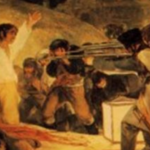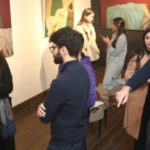1) Shiblee please tell us a little about your art background
Shiblee Muneer was born in Jhang, in a family of artists, where miniature painting was practiced for centuries. The family legend has it that his ancestors followed the first Mughal Emperor Babur from Afghanistan to Persia then India, as part of his team of painters and calligraphers.
Members of his family remained at Delhi Court until the early 19thcentury. However, with the decline of Mughal power and art patronage, they moved to Patiala transferring the traditional Mughal painterly technique to the Sikh-ruled court.
Muneer’s great, great, grandfather, Ustad Allah Ditta founded the princely painting gharana at Patiala where the so-called ‘Pahari’ style of miniature painting developed under his guidance. Ustad Allah Ditta’s grandson, and Muneer’s grandfather, Ustad Haji Mohammad Sharif (1889-1978) was a well-known painter in the Indian subcontinent and his fame was also international, through the UK’s India Society. He was based at Patiala and traveled to other regions on request of his employer, Maharajah Bhupinder Singh (1891-1938). Several years after the death of Maharaja, Ustad Haji Sharif was requested for a teaching appointment at the Mayo School of the Arts, now National College of Arts. Thus the family settled permanently in Lahore after the partition of India. Heading the Miniature Department at the Mayo School of Arts in 1945-1966, Haji Sharif developed the first curriculum for teaching miniature painting at an academic institution, and he trained the first cohort of miniaturists in independent Pakistan. He is considered the founder of Pakistani miniature painting.
The painting tradition is passed from generation to generation in Muneer’s family. Both male and female family members begin learning the philosophy and techniques involved in creating a miniature at home, and later they apprentice with other master painters, from paper production, to the mixing of pigments, to calligraphy, coloring and shading.
Shiblee Muneer followed apprenticeship training in calligraphy and painting from an early age and studied at the Naqsh School of Arts and the Beaconhouse National University. He teaches at the Institute of Visual Arts & Design at the Lahore College for Women University (LCWU). He is a practicing artist and conducts workshops for children in miniature painting.
Muneer carries his responsibility as the guardian of miniature painting tradition but finds inspiration in post-modernist philosophy and new techniques: computer graphics, digitally- manipulated images, hyper-realistic painting and collage. He experiments the rich, strict canons of miniature painting with contemporary techniques; this has brought him a place on the list of “Asia’s 10 Most-Inspiring Visual Artists” in the Top 10 of Asia magazine in 2014, and was recently awarded the ‘Best Contemporary Painter of Pakistan’ by the prestigious art publication, Nigaah Art Awards 2023.


2) You are famous for your miniature style of painting but in recent years have been exploring various mediums of calligraphy as well. Which do you enjoy more?
I do not consider myself as a medium specific artist. I believe my practices are based more on concepts rather on any medium, moreover I apply medium as a stimulating element of my conception while forming an artwork. Primarily I enjoy the reaction from the public on my works that gives me more comprehension about mediums that could extend in further works.


3) What is the central concept behind your current theme?
Vision is always a socialized phenomenon that is defined to us by our surrounding culture.
Indeed, image-making serves as a powerful conduit to challenge and reshape our perception of reality.


Through these deliberate arrangements/distortions;
I seek to unravel the layers between what we perceive and what truly exists. Through my current body of work, I navigate the intricate rave between representation and the tangible, inviting viewers to question the authenticity of their visual experiences. Each stroke and composition serve as a portal, challenging preconceived notions and prompting a reconsideration of the complex relationship between images and the reality they purport to capture.
I don’t have personal beliefs or trust in Historic Images. However, it’s important to approach historical images critically. While they can provide valuable insights in the past, factors like bias-perspective, selective representation and capitalist’s interest may influence their accuracy.
The visual representations we encounter every day are not “slices of life” cut out of a stable reality obtained by the gods.
They are artificial organizations of meaning.


4) Tell us about the process of your research for your current show. How did you come up with the concept of each painting?
The current body of work is a response against the stereotype approach towards us.
(we as the people of subcontinent) commonly face certain propagative statements from our invaders that merely initiated through the
“commercial fibs” to end up with a firm image of idiocracy in order to repugnant us on our luxurious past and entrusts us on that colonial line.
5) Please tell us about the various techniques you have used in the entire show
This show can be considered as a “feast of image making techniques”.
Since I own a diverse context of art apprentice that strengthens my virtuosity more than any academic artist. Hence the traditional renditions (Pardakht) come from my heritage, the collage methods learned from academia and serigraphy came from my cinema billboard workshop.
6) Which technique is your favorite?
All techniques bring some specific challenges and a kind of accomplishments in it. so, I think all are my favorite ones. However, By the time, they are become toxic for an artistic solution that is why, I hate all of them and looking forward…


7) Which technique is the most time-consuming?
Apparently, traditional rendering takes a hefty time from my life, however, in this case; the collage techniques equally prosecute me well.
8) The artwork you produced for the show is stunning and also scandalous. Do you think people appreciate such art in Pakistan?
To appreciate art, one needs to be a civilized person of any society and luckily my society is considered one of the most civilized ones, who appreciates such scandalous/Mms stories at the top of the world (approved by Google) J
9) Do you have to face any issues with people around you in producing these works?
Unfortunately, I do not socialize normally in any sphere hence I do not encounter anyone except one message from my official group member (must be a professor) “The honorable person was alleging me to a conviction of cybercrime, according to him I should not discussed such things in public” I replied to him, rather have to show you personally?
10) What is next for Shiblee Muneer?
Must be a poke on a sensitive organ.
Because we are going through a critical period.







